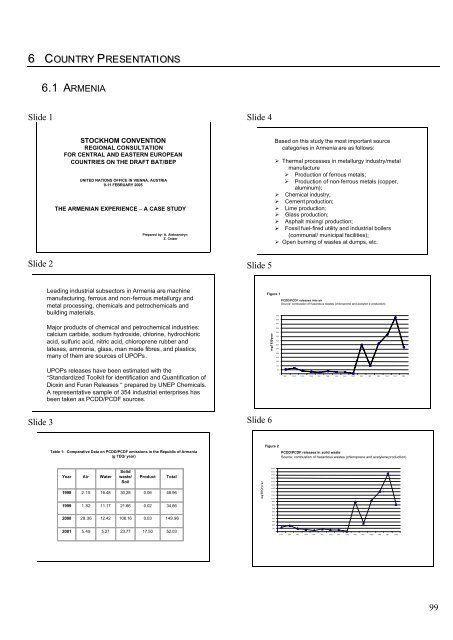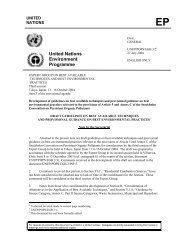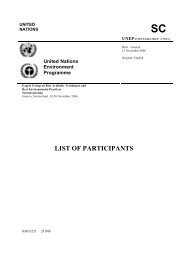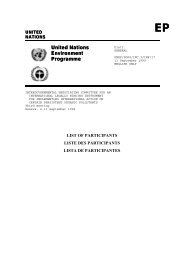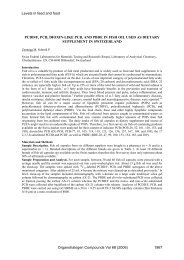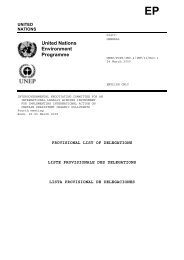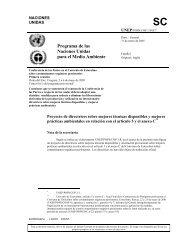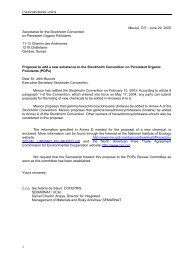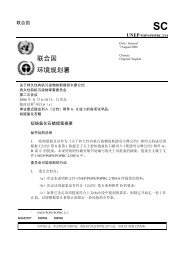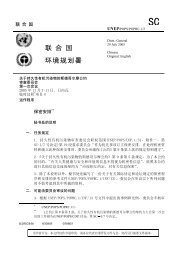United Nations Environment Programme - Stockholm Convention on ...
United Nations Environment Programme - Stockholm Convention on ...
United Nations Environment Programme - Stockholm Convention on ...
You also want an ePaper? Increase the reach of your titles
YUMPU automatically turns print PDFs into web optimized ePapers that Google loves.
6 COUNTRY PRESENTATIONS<br />
6.1 ARMENIA<br />
Slide 1<br />
Slide 4<br />
STOCKHOM CONVENTION<br />
REGIONAL CONSULTATION<br />
FOR CENTRAL AND EASTERN EUROPEAN<br />
COUNTRIES ON THE DRAFT BAT/BEP<br />
UNITED NATIONS OFFICE IN VIENNA, AUSTRIA<br />
9-11 FEBRUARY 2005<br />
THE ARMENIAN EXPERIENCE – A CASE STUDY<br />
Prepared by: A. Aleksandryn<br />
Z. Csizer<br />
Based <strong>on</strong> this study the most important source<br />
categories in Armenia are as follows:<br />
‣ Thermal processes in metallurgy industry/metal<br />
manufacture<br />
‣ Producti<strong>on</strong> of ferrous metals;<br />
‣ Producti<strong>on</strong> of n<strong>on</strong>-ferrous metals (copper,<br />
aluminum);<br />
‣ Chemical industry;<br />
‣ Cement producti<strong>on</strong>;<br />
‣ Lime producti<strong>on</strong>;<br />
‣ Glass producti<strong>on</strong>;<br />
‣ Asphalt mixing/ producti<strong>on</strong>;<br />
‣ Fossil fuel-fired utility and industrial boilers<br />
(communal/ municipal facilities);<br />
‣ Open burning of wastes at dumps, etc.<br />
Slide 2<br />
Slide 5<br />
Leading industrial subsectors in Armenia are machine<br />
manufacturing, ferrous and n<strong>on</strong>-ferrous metallurgy and<br />
metal processing, chemicals and petrochemicals and<br />
building materials.<br />
Major products of chemical and petrochemical industries:<br />
calcium carbide, sodium hydroxide, chlorine, hydrochloric<br />
acid, sulfuric acid, nitric acid, chloroprene rubber and<br />
latexes, amm<strong>on</strong>ia, glass, man made fibres, and plastics;<br />
many of them are sources of UPOPs.<br />
Figure 1<br />
mgTEQ/year<br />
PCDD/PCDF releases into air<br />
Source: combusti<strong>on</strong> of hazardous wastes (chloroprene and acetylen e producti<strong>on</strong>)<br />
7000<br />
6500<br />
6000<br />
5500<br />
5000<br />
4500<br />
4000<br />
3500<br />
3000<br />
2500<br />
2000<br />
1500<br />
UPOPs releases have been estimated with the<br />
“Standardized Toolkit for identificati<strong>on</strong> and Quantificati<strong>on</strong> of<br />
Dioxin and Furan Releases ” prepared by UNEP Chemicals.<br />
A representative sample of 354 industrial enterprises has<br />
been taken as PCDD/PCDF sources.<br />
1000<br />
500<br />
0<br />
2001 2000 1999 1998 1997 1996 1995 1994 1993 1992 1991 1989 1988 1987 1985<br />
Slide 3<br />
Slide 6<br />
Table 1: Comparative Data <strong>on</strong> PCDD/PCDF emissi<strong>on</strong>s in the Republic of Armenia<br />
(g TEQ/ year)<br />
Figure 2<br />
PCDD/PCDF releases in solid waste<br />
Source: combusti<strong>on</strong> of hazardous wastes (chloroprene and acetylene producti<strong>on</strong>)<br />
Year Air Water<br />
Solid<br />
waste/<br />
Soil<br />
Product<br />
Total<br />
1998 2.15 16.48 30,28 0.06 48.96<br />
1999 1.82 11.17 21.66 0.02 34.66<br />
2000 28.36 12.42 108.16 0.03 149.96<br />
mgTEQ/year<br />
19000<br />
18000<br />
17000<br />
16000<br />
15000<br />
14000<br />
13000<br />
12000<br />
11000<br />
10000<br />
9000<br />
8000<br />
7000<br />
6000<br />
5000<br />
4000<br />
3000<br />
2000<br />
2001 5.49 5.27 23.77 17.50 52.03<br />
1000<br />
0<br />
2001 2000 1999 1998 1997 1996 1995 1994 1993 1992 1991 1989 1988 1987 1985<br />
99


